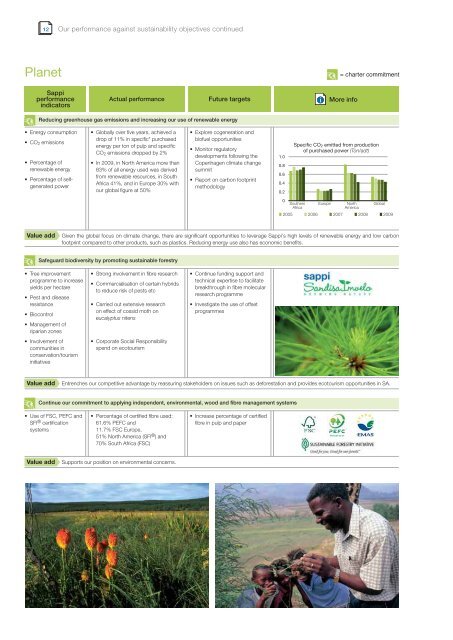Our performance in 2009 - Sappi
Our performance in 2009 - Sappi
Our performance in 2009 - Sappi
Create successful ePaper yourself
Turn your PDF publications into a flip-book with our unique Google optimized e-Paper software.
12<br />
<strong>Our</strong> <strong>performance</strong> aga<strong>in</strong>st susta<strong>in</strong>ability objectives cont<strong>in</strong>ued<br />
Planet = charter commitment<br />
<strong>Sappi</strong><br />
<strong>performance</strong><br />
<strong>in</strong>dicators<br />
Reduc<strong>in</strong>g greenhouse gas emissions and <strong>in</strong>creas<strong>in</strong>g our use of renewable energy<br />
Energy consumption<br />
CO2 emissions<br />
Percentage of<br />
renewable energy<br />
Percentage of selfgenerated<br />
power<br />
Globally over five years, achieved a<br />
drop of 11% <strong>in</strong> specific* purchased<br />
energy per ton of pulp and specific<br />
CO2 emissions dropped by 2%<br />
In <strong>2009</strong>, <strong>in</strong> North America more than<br />
83% of all energy used was derived<br />
from renewable resources, <strong>in</strong> South<br />
Africa 41%, and <strong>in</strong> Europe 30% with<br />
our global figure at 50%<br />
Explore cogeneration and<br />
biofuel opportunities<br />
Monitor regulatory<br />
developments follow<strong>in</strong>g the<br />
Copenhagen climate change<br />
summit<br />
Report on carbon footpr<strong>in</strong>t<br />
methodology<br />
Value add Given the global focus on climate change, there are significant opportunities to leverage <strong>Sappi</strong>’s high levels of renewable energy and low carbon<br />
footpr<strong>in</strong>t compared to other products, such as plastics. Reduc<strong>in</strong>g energy use also has economic benefits.<br />
Safeguard biodiversity by promot<strong>in</strong>g susta<strong>in</strong>able forestry<br />
Tree improvement<br />
programme to <strong>in</strong>crease<br />
yields per hectare<br />
Pest and disease<br />
resistance<br />
Biocontrol<br />
Management of<br />
riparian zones<br />
Involvement of<br />
communities <strong>in</strong><br />
conservation/tourism<br />
<strong>in</strong>itiatives<br />
Strong <strong>in</strong>volvement <strong>in</strong> fibre research<br />
Commercialisation of certa<strong>in</strong> hybrids<br />
to reduce risk of pests etc<br />
Carried out extensive research<br />
on effect of cossid moth on<br />
eucalyptus nitens<br />
Corporate Social Responsibility<br />
spend on ecotourism<br />
Cont<strong>in</strong>ue fund<strong>in</strong>g support and<br />
technical expertise to facilitate<br />
breakthrough <strong>in</strong> fibre molecular<br />
research programme<br />
Investigate the use of offset<br />
programmes<br />
Value add Entrenches our competitive advantage by reassur<strong>in</strong>g stakeholders on issues such as deforestation and provides ecotourism opportunities <strong>in</strong> SA.<br />
Cont<strong>in</strong>ue our commitment to apply<strong>in</strong>g <strong>in</strong>dependent, environmental, wood and fibre management systems<br />
Use of FSC, PEFC and<br />
SFI ® certification<br />
systems<br />
Percentage of certified fibre used:<br />
61.6% PEFC and<br />
11.7% FSC Europe,<br />
51% North America (SFI ® ) and<br />
70% South Africa (FSC)<br />
Value add Supports our position on environmental concerns.<br />
Actual <strong>performance</strong> Future targets i<br />
More <strong>in</strong>fo<br />
Increase percentage of certified<br />
fibre <strong>in</strong> pulp and paper
















